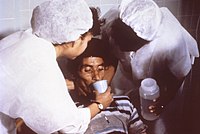
Photo from wikipedia
Supplemental Digital Content is available in the text. OBJECTIVES: Cirrhosis is associated with hemodynamic and vascular disorders. However, microvascular reactivity of cirrhotic patients in the context of sepsis has poorly… Click to show full abstract
Supplemental Digital Content is available in the text. OBJECTIVES: Cirrhosis is associated with hemodynamic and vascular disorders. However, microvascular reactivity of cirrhotic patients in the context of sepsis has poorly been investigated. DESIGN: Prospective observational study. SETTING: Medical ICU in a tertiary teaching hospital. PATIENTS: We prospectively included adult patients admitted in the ICU for septic shock with and without cirrhosis. After initial resuscitation, global hemodynamic parameters were recorded and skin microvascular reactivity to local acetylcholine iontophoresis was measured. INTERVENTIONS: None. MEASUREMENTS AND MAIN RESULTS: Thirty patients with septic shock were included (60% male), 10 with cirrhosis and 20 without, with a median age of 61 years (54–74 yr). Cirrhotic patients were mainly classed as Child-Pugh C (80%) and all of them had ascites. Sequential Organ Failure Assessment score and ICU mortality of cirrhotic patients were higher than the noncirrhotic patients, respectively (6.5 [5.0–8.3] vs 11.5 [9.0–14.0]; p < 0.01; 15% vs 70%; p < 0.01). Peripheral tissue perfusion and global hemodynamic parameters were not different between the cirrhotic and noncirrhotic patients but arterial lactate level was three times higher in patients with cirrhosis (6.0 mmol/L [3.9–8.0 mmol/L] vs 2.0 mmol/L [0.9–3.5 mmol/L]; p < 0.01). Basal skin microvascular blood flow was not statistically different between the groups (4.94 perfusion units [3.45–8.73 perfusion units] vs 6.95 perfusion units [5.24–8.38 perfusion units]; p = 0.29). After acetylcholine simulation, skin microvascular blood flow increased more in cirrhotic patients than in noncirrhotic patients (644% [217–966%] vs 169% [73–505%], p = 0.03). Global microvascular reactivity was seven times higher in cirrhotic patients (area under the curve, 16,412 perfusion units [13,898–19,041 perfusion units] vs 2,664 perfusion units [969–4,604 perfusion units]; p < 0.001). CONCLUSIONS: We identified an exaggerated vasodilating microvascular response in cirrhotic patients with septic shock. Such a result may explain vasopressor resistance and paves the way for future therapeutic trials, targeting nitric oxide pathway specifically in this population.
Journal Title: Critical Care Medicine
Year Published: 2021
Link to full text (if available)
Share on Social Media: Sign Up to like & get
recommendations!